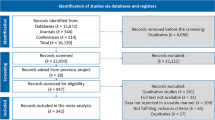Abstract
Stroke knowledge is poor and stroke risk is growing for the U.S. Latino immigrant population. We present results of an evaluation of a tailored, community-based intervention in Durham, North Carolina. The intervention included integration of stroke knowledge into classes and workshops at a community-based organization. Knowledge surveys were administered to participants immediately before and after stroke education, and at multiple points over the following year. For both low-risk participants receiving classroom-based education and individually care managed participants with risk factors, stroke knowledge improved dramatically and remained high among those who could be reached for follow-up. Evidence of behavior change and change in clinical status was weak. These findings from an observational study conducted in a real-world context complement the results of previously reported efficacy studies, indicating potential gains from health education for Latino immigrants, even from classroom-based education for low-risk individuals.






Similar content being viewed by others
Notes
El Centro Hispano has strong LGBTQ programming.
References
CDC. Awareness of stroke warning symptoms—13 states and the district of Columbia, 2005. MMWR 2008; 57(18):481–5.
CDC: Stroke. 2015. http://www.cdc.gov/stroke/ [updated September 1, 2015; cited 2015 September 3, 2015]
Chiuve S, et al. Adherence to a low-risk, healthy lifestyle and risk of sudden cardiac death among women. JAMA. 2011;306(1):62–9.
Lees K, et al. Time to treatment with intravenous alteplase and outcome in stroke: an updated pooled analysis of ECASS, ATLANTIS, NINDS, and EPITHET trials. Lancet. 2010;375(9727):1695–703.
Powers W, et al. 2015 AHA/ASA focused update of the 2013 guidelines for the early management of patients with acute ischemic stroke regarding endovascular treatment. Stroke. 2015;46(10):3020–35.
Pancioli A, et al. Public perceptions of stroke warning signs and knowledge of potential risk factors. JAMA. 1998;279(16):1288–92.
Schneider A, et al. Trends in community knowledge of the warning signs and risk factors for stroke. JAMA. 2003;289(3):343–6.
Williams L, et al. Stroke patients’ knowledge of stroke: influence on time to presentation. Stroke. 1997;28(5):912–5.
Cheung R. Hong Kong patients’ knowledge of stroke does not influence time to hospital presentation. J Clin Neurosci. 2001;8(4):311–4.
Kip K, et al. Absence of risk factor change in young adults after family heart attack or stroke: the CARDIA study. Am J Prev Med. 2002;22(4):258–66.
Morgenstern L, Kissela B. Stroke disparities: Large global problem that must be addressed. Stroke. 2015;46(12):3560–3.
Goldstein LB, et al. Stroke-related knowledge among uninsured Latino immigrants in Durham County, North Carolina. J Stroke Cerebrovasc Dis. 2009;18(3):229–31.
Sacco F, et al. Stroke incidence among White, Black, and Hispanic residents of an urban community: the Northern Manhattan Stroke Study. Am J Epidemiol. 1998;147(3):259–68.
Vega-Lopez S, et al. Triglyceride screening may improve cardiometabolic disease risk assessment in Latinos with poorly controlled type 2 diabetes. J Health Care Poor Underserved. 2013;24(4):1739–55.
Perez-Escamilla R, et al. Health care access among hispanic immigrants: ¿Alguien esta escuchando? [Is anybody listening?] NAPA Bulletin. 2010;34(1):47–67.
Motel S, Patten E. Statistical portrait of the foreign-born population in the United States, 2011. Washington DC: Pew Research Hispanic Trends Project; published January 29, 2013.
Adler NE, Newman K. Socioeconomic disparities in health: pathways and policies. Health Aff. 2002;21(2):60–76.
Alberts M, et al. Effects of public and professional education on reducing the delay in presentation and referral of stroke patients. Stroke. 1992;23(3):352–6.
Morgenstern L, et al. Improving delivery of acute stroke therapy: the TLL Temple Foundation Stroke Project. Stroke. 2002;33(1):160–6.
Silver F, et al. Advertising strategies to increase public knowledge of the warning signs of stroke. Stroke. 2003;34(8):1965–9.
Kleindorfer D, et al. Designing a message for public education regarding stroke: does FAST capture enough stroke? Stroke. 2007;38(10):2864–8.
Gardois P, et al. Health promotion interventions for increasing stroke awareness in ethnic minorities: a systematic review of the literature. BMC Public Health. 2014;14:409.
Pekmezi D, et al. Health promotion in Latinos. Am J Lifestyle Med 2001;4(2):151–65.
Brown D, et al. Multicomponent behavioral intervention to reduce stroke risk factor behaviors: the stroke health and risk education cluster-randomized controlled trial. Stroke. 2015;46(10):2861–7.
Kronish I, et al. Effect of peer education on stroke prevention: the prevent recurrence of all inner-city strokes through education randomized controlled trial. Stroke. 2014;45(11):3330–6.
Partnership for a Healthy Durham: Durham County Community Health Assessment 2011. Published December 2011.
Hugo Lopez A, Gonzalez-Barrera A, Cuddington D. Diverse origins: the nationa’s 14 largest Hispanic-origin groups. Report of the Pew Research Center Published June 19, 2013.
Bandura A. Perceived self-efficacy in the exercise of control over AIDS infection. Eval Progr Plan. 1990;13:9–17.
Acknowledgements
The authors gratefully acknowledge the support of the Kate B. Reynolds Charitable Trust, which provided funding for this study, as well as El Centro Hispano, which administered the grant funding, oversaw program activities, and participated actively in data collection.
Author information
Authors and Affiliations
Corresponding author
Rights and permissions
About this article
Cite this article
Silberberg, M., Goldstein, L.B., Weaver, S. et al. Increasing Stroke Knowledge and Decreasing Stroke Risk in a Latino Immigrant Population. J Immigrant Minority Health 20, 1490–1499 (2018). https://doi.org/10.1007/s10903-018-0690-0
Published:
Issue Date:
DOI: https://doi.org/10.1007/s10903-018-0690-0




